Yamaha XC115S Manual
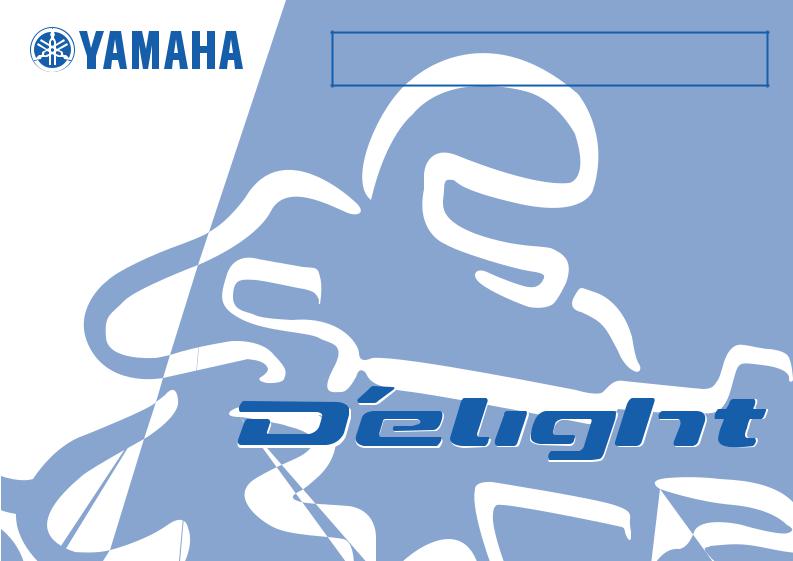
 Read this manual carefully before operating this vehicle.
Read this manual carefully before operating this vehicle.
OWNER’S MANUAL
XC115S
2EP-F8199-E0

EAU46090
 Read this manual carefully before operating this vehicle. This manual should stay with this vehicle if it is sold.
Read this manual carefully before operating this vehicle. This manual should stay with this vehicle if it is sold.
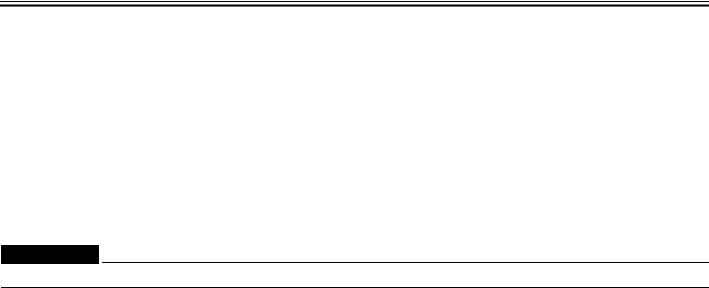
INTRODUCTION
EAU10113
Welcome to the Yamaha world of motorcycling!
As the owner of the XC115S, you are benefiting from Yamaha’s vast experience and newest technology regarding the design and manufacture of high-quality products, which have earned Yamaha a reputation for dependability.
Please take the time to read this manual thoroughly, so as to enjoy all advantages of your XC115S. The Owner’s Manual does not only instruct you in how to operate, inspect and maintain your scooter, but also in how to safeguard yourself and others from trouble and injury.
In addition, the many tips given in this manual will help keep your scooter in the best possible condition. If you have any further questions, do not hesitate to contact your Yamaha dealer.
The Yamaha team wishes you many safe and pleasant rides. So, remember to put safety first!
Yamaha continually seeks advancements in product design and quality. Therefore, while this manual contains the most current product information available at the time of printing, there may be minor discrepancies between your scooter and this manual. If there is any question concerning this manual, please consult a Yamaha dealer.
EWA12411
 WARNING
WARNING
Please read this manual carefully and completely before operating this scooter.

IMPORTANT MANUAL INFORMATION
EAU10133
Particularly important information is distinguished in this manual by the following notations:
|
|
|
|
This is the safety alert symbol. It is used to alert you to potential personal injury |
|
|
|
|
hazards. Obey all safety messages that follow this symbol to avoid possible injury |
|
|
|
|
or death. |
|
|
|
|
|
|
|
|
|
|
|
|
|
|
A WARNING indicates a hazardous situation which, if not avoided, could result in |
|
WARNING |
|
||
|
|
death or serious injury. |
||
|
|
|
|
|
|
|
|
|
|
|
|
|
|
|
|
|
|
|
A NOTICE indicates special precautions that must be taken to avoid damage to the |
|
NOTICE |
|
|
|
|
|
vehicle or other property. |
||
|
|
|
|
|
|
|
|
|
|
TIP |
A TIP provides key information to make procedures easier or clearer. |
|
|
*Product and specifications are subject to change without notice.
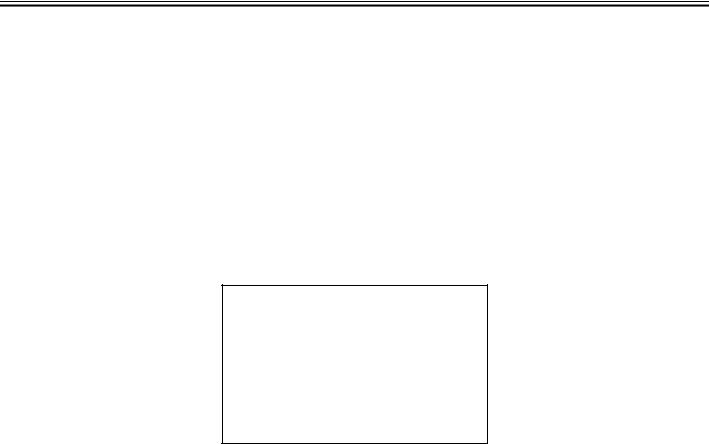
IMPORTANT MANUAL INFORMATION
EAU37431
XC115S
OWNER’S MANUAL
©2013 by Thai Yamaha Motor Co., Ltd. 1st edition, March 2013
All rights reserved.
Any reprinting or unauthorized use without the written permission of Thai Yamaha Motor Co., Ltd.
is expressly prohibited. Printed in Thailand.

TABLE OF CONTENTS
SAFETY INFORMATION .................. |
1-1 |
FOR YOUR SAFETY – |
|
Tires ............................................. |
6-15 |
Further safe-riding points ................ |
1-5 |
PRE-OPERATION CHECKS ............. |
4-1 |
Cast wheels ................................. |
6-17 |
|
|
|
|
Checking the front brake lever |
|
DESCRIPTION .................................. |
2-1 |
OPERATION AND IMPORTANT |
|
free play .................................... |
6-17 |
Left view .......................................... |
2-1 |
RIDING POINTS................................. |
5-1 |
Adjusting the rear brake lever |
|
Right view ........................................ |
2-2 |
Starting the engine ......................... |
5-1 |
free play .................................... |
6-18 |
Controls and instruments................. |
2-3 |
Starting off ...................................... |
5-2 |
Checking the front brake pads |
|
|
|
Acceleration and deceleration ........ |
5-2 |
and rear brake shoes ............... |
6-18 |
INSTRUMENT AND CONTROL |
|
Braking ........................................... |
5-3 |
Checking the brake fluid level ...... |
6-19 |
FUNCTIONS ....................................... |
3-1 |
Tips for reducing fuel |
|
Changing the brake fluid .............. |
6-20 |
Main switch/steering lock ................ |
3-1 |
consumption ............................... |
5-3 |
Checking and lubricating the |
|
Keyhole cover ................................. |
3-2 |
Engine break-in .............................. |
5-3 |
cables ....................................... |
6-20 |
Indicator lights and warning light .... |
3-2 |
Parking ........................................... |
5-4 |
Checking and lubricating the |
|
Speedometer unit ........................... |
3-3 |
|
|
throttle grip and cable ............... |
6-20 |
Handlebar switches ........................ |
3-3 |
PERIODIC MAINTENANCE AND |
|
Lubricating the front and rear |
|
Front brake lever ............................ |
3-4 |
ADJUSTMENT ................................... |
6-1 |
brake levers .............................. |
6-21 |
Rear brake lever ............................. |
3-4 |
Owner’s tool kit ............................... |
6-2 |
Checking and lubricating the |
|
Fuel tank cap .................................. |
3-5 |
Periodic maintenance chart for the |
|
centerstand and sidestand ....... |
6-21 |
Fuel ................................................. |
3-5 |
emission control system ............. |
6-3 |
Checking the front fork ................. |
6-22 |
Catalytic converter .......................... |
3-6 |
General maintenance and |
|
Checking the steering .................. |
6-23 |
Seat ................................................ |
3-7 |
lubrication chart .......................... |
6-4 |
Checking the wheel bearings ....... |
6-23 |
Helmet holders ............................... |
3-8 |
Removing and installing the |
|
Battery ......................................... |
6-23 |
Storage compartments ................... |
3-9 |
cowling and panels ..................... |
6-7 |
Replacing the fuse ....................... |
6-25 |
Luggage hook ............................... |
3-10 |
Checking the spark plug ................. |
6-8 |
Replacing the headlight bulb ....... |
6-26 |
Sidestand ...................................... |
3-10 |
Engine oil and oil strainer ............. |
6-10 |
Replacing a tail/brake light bulb or |
|
Ignition circuit cut-off system ........ |
3-11 |
Final transmission oil .................... |
6-12 |
a rear turn signal light bulb ....... |
6-27 |
|
|
Air filter and V-belt case air filter |
|
Replacing a front turn signal light |
|
|
|
elements ................................... |
6-13 |
bulb ........................................... |
6-28 |
|
|
Adjusting the throttle grip free |
|
Troubleshooting ........................... |
6-28 |
|
|
play ........................................... |
6-15 |
Troubleshooting chart .................. |
6-30 |
|
|
Valve clearance ............................ |
6-15 |
|
|

TABLE OF CONTENTS
SCOOTER CARE AND STORAGE ... |
7-1 |
Matte color caution ......................... |
7-1 |
Care ................................................ |
7-1 |
Storage ........................................... |
7-4 |
SPECIFICATIONS ............................. |
8-1 |
CONSUMER INFORMATION............. |
9-1 |
Identification numbers .................... |
9-1 |

 SAFETY INFORMATION
SAFETY INFORMATION
EAU1026A
1Be a Responsible Owner
As the vehicle’s owner, you are responsible for the safe and proper operation of your scooter.
Scooters are single-track vehicles. Their safe use and operation are dependent upon the use of proper riding techniques as well as the expertise of the operator. Every operator should know the following requirements before riding this scooter.
He or she should:
●Obtain thorough instructions from a competent source on all aspects of scooter operation.
●Observe the warnings and maintenance requirements in this Owner’s Manual.
●Obtain qualified training in safe and proper riding techniques.
●Obtain professional technical service as indicated in this Owner’s Manual and/or when made necessary by mechanical conditions.
●Never operate a scooter without proper training or instruction. Take a training course. Beginners should receive training from a certified instructor. Contact an authorized scooter dealer to find out about the training courses nearest you.
Safe Riding
Perform the pre-operation checks each time you use the vehicle to make sure it is in safe operating condition. Failure to inspect or maintain the vehicle properly increases the possibility of an accident or equipment damage. See page 4-1 for a list of pre-operation checks.
●This scooter is designed to carry the operator and a passenger.
●The failure of motorists to detect and recognize scooters in traffic is the predominating cause of automobile/scooter accidents. Many accidents have been caused by an automobile driver who did not see the scooter. Making yourself con-
spicuous appears to be very effective in reducing the chance of this type of accident.
Therefore:
•Wear a brightly colored jacket.
•Use extra caution when you are approaching and passing through intersections, since intersections are the most likely places for scooter accidents to occur.
•Ride where other motorists can see you. Avoid riding in another motorist’s blind spot.
•Never maintain a scooter without proper knowledge. Contact an authorized scooter dealer to inform you on basic scooter maintenance. Certain maintenance can only be carried out by certified staff.
1-1

 SAFETY INFORMATION
SAFETY INFORMATION
●Many accidents involve inexperienced operators. In fact, many operators who have been involved in accidents do not even have a current driver’s license.
•Make sure that you are qualified and that you only lend your scooter to other qualified operators.
•Know your skills and limits. Staying within your limits may help you to avoid an accident.
•We recommend that you practice riding your scooter where there is no traffic until you have become thoroughly familiar with the scooter and all of its controls.
●Many accidents have been caused by error of the scooter operator. A typical error made by the operator is veering wide on a turn due to excessive speed or undercornering (insufficient lean angle for the speed).
•Always obey the speed limit and never travel faster than warranted by road and traffic conditions.
•Always signal before turning or changing lanes. Make sure that other motorists can see you.
●The posture of the operator and passenger is important for proper control.
•The operator should keep both hands on the handlebar and both feet on the operator footrests during operation to maintain control of the scooter.
•The passenger should always hold onto the operator, the seat strap or grab bar, if equipped, with both hands and keep both feet on the passenger footrests. Never carry a passenger unless he or she can firmly place both feet on the passenger footrests.
●Never ride under the influence of alcohol or other drugs.
●This scooter is designed for onroad use only. It is not suitable for off-road use.
Protective Apparel
The majority of fatalities from scooter accidents are the result of head injuries. The use of a safety helmet is the 1 single most critical factor in the preven-
tion or reduction of head injuries.
●Always wear an approved helmet.
●Wear a face shield or goggles. Wind in your unprotected eyes could contribute to an impairment of vision that could delay seeing a hazard.
●The use of a jacket, substantial shoes, trousers, gloves, etc., is effective in preventing or reducing abrasions or lacerations.
●Never wear loose-fitting clothes, otherwise they could catch on the control levers or wheels and cause injury or an accident.
●Always wear protective clothing that covers your legs, ankles, and feet. The engine or exhaust system become very hot during or after operation and can cause burns.
●A passenger should also observe the above precautions.
1-2

 SAFETY INFORMATION
SAFETY INFORMATION
Avoid Carbon Monoxide Poisoning
All engine exhaust contains carbon monoxide, a deadly gas. Breathing car-
1bon monoxide can cause headaches, dizziness, drowsiness, nausea, confusion, and eventually death.
Carbon Monoxide is a colorless, odorless, tasteless gas which may be present even if you do not see or smell any engine exhaust. Deadly levels of carbon monoxide can collect rapidly and you can quickly be overcome and unable to save yourself. Also, deadly levels of carbon monoxide can linger for hours or days in enclosed or poorly ventilated areas. If you experience any symptoms of carbon monoxide poisoning, leave the area immediately, get fresh air, and SEEK MEDICAL TREATMENT.
●Do not run engine indoors. Even if you try to ventilate engine exhaust with fans or open windows and doors, carbon monoxide can rapidly reach dangerous levels.
●Do not run engine in poorly ventilated or partially enclosed areas such as barns, garages, or carports.
●Do not run engine outdoors where engine exhaust can be drawn into a building through openings such as windows and doors.
Loading
Adding accessories or cargo to your scooter can adversely affect stability and handling if the weight distribution of the scooter is changed. To avoid the possibility of an accident, use extreme caution when adding cargo or accessories to your scooter. Use extra care when riding a scooter that has added cargo or accessories. Here, along with the information about accessories below, are some general guidelines to follow if loading cargo to your scooter:
The total weight of the operator, passenger, accessories and cargo must not exceed the maximum load limit.
Operation of an overloaded vehicle could cause an accident.
Maximum load:
156 kg (345 lb)
When loading within this weight limit, keep the following in mind:
1-3
●Cargo and accessory weight should be kept as low and close to the scooter as possible. Securely pack your heaviest items as close to the center of the vehicle as possible and make sure to distribute the weight as evenly as possible on both sides of the scooter to minimize imbalance or instability.
●Shifting weights can create a sudden imbalance. Make sure that accessories and cargo are securely attached to the scooter before riding. Check accessory mounts and cargo restraints frequently.
•Properly adjust the suspension for your load (suspension-ad- justable models only), and check the condition and pressure of your tires.
•Never attach any large or heavy items to the handlebar, front fork, or front fender. Such items can create unstable handling or a slow steering response.
●This vehicle is not designed to pull a trailer or to be attached to a sidecar.

 SAFETY INFORMATION
SAFETY INFORMATION
Genuine Yamaha Accessories
Choosing accessories for your vehicle is an important decision. Genuine Yamaha accessories, which are available only from a Yamaha dealer, have been designed, tested, and approved by Yamaha for use on your vehicle.
Many companies with no connection to Yamaha manufacture parts and accessories or offer other modifications for Yamaha vehicles. Yamaha is not in a position to test the products that these aftermarket companies produce. Therefore, Yamaha can neither endorse nor recommend the use of accessories not sold by Yamaha or modifications not specifically recommended by Yamaha, even if sold and installed by a Yamaha dealer.
Aftermarket Parts, Accessories, and Modifications
While you may find aftermarket products similar in design and quality to genuine Yamaha accessories, recognize that some aftermarket accessories or modifications are not suitable because of potential safety hazards to you or others. Installing aftermarket prod-
ucts or having other modifications performed to your vehicle that change any of the vehicle’s design or operation characteristics can put you and others at greater risk of serious injury or death. You are responsible for injuries related to changes in the vehicle.
Keep the following guidelines in mind, as well as those provided under “Loading” when mounting accessories.
●Never install accessories or carry cargo that would impair the performance of your scooter. Carefully inspect the accessory before using it to make sure that it does not in any way reduce ground clearance or cornering clearance, limit suspension travel, steering travel or control operation, or obscure lights or reflectors.
•Accessories fitted to the handlebar or the front fork area can create instability due to improper weight distribution or aerodynamic changes. If accessories are added to the handlebar or front fork area, they must be as lightweight as possible and should be kept to a minimum.
•Bulky or large accessories may seriously affect the stability of the scooter due to aerodynamic
effects. Wind may attempt to lift |
1 |
the scooter, or the scooter may |
|
become unstable in cross winds. These accessories may also cause instability when passing or being passed by large vehicles.
•Certain accessories can displace the operator from his or her normal riding position. This improper position limits the freedom of movement of the operator and may limit control ability, therefore, such accessories are not recommended.
●Use caution when adding electrical accessories. If electrical accessories exceed the capacity of the scooter’s electrical system, an electric failure could result, which could cause a dangerous loss of lights or engine power.
1-4

 SAFETY INFORMATION
SAFETY INFORMATION
Aftermarket Tires and Rims
The tires and rims that came with your scooter were designed to match the
1performance capabilities and to provide the best combination of handling, braking, and comfort. Other tires, rims, sizes, and combinations may not be appropriate. Refer to page 6-15 for tire specifications and more information on replacing your tires.
Transporting the Scooter
Be sure to observe following instructions before transporting the scooter in another vehicle.
●Remove all loose items from the scooter.
●Point the front wheel straight ahead on the trailer or in the truck bed, and choke it in a rail to prevent movement.
●Secure the scooter with tie-downs or suitable straps that are attached to solid parts of the scooter, such as the frame or upper front fork triple clamp (and not, for example, to rubber-mounted handlebars or turn signals, or parts that could break). Choose the location for the
straps carefully so the straps will not rub against painted surfaces during transport.
●The suspension should be compressed somewhat by the tiedowns, if possible, so that the scooter will not bounce excessively during transport.
EAU10373
Further safe-riding points
●Be sure to signal clearly when making turns.
●Braking can be extremely difficult on a wet road. Avoid hard braking, because the scooter could slide. Apply the brakes slowly when stopping on a wet surface.
●Slow down as you approach a corner or turn. Once you have completed a turn, accelerate slowly.
●Be careful when passing parked cars. A driver might not see you and open a door in your path.
●Railroad crossings, streetcar rails, iron plates on road construction sites, and manhole covers become extremely slippery when wet. Slow down and cross them with caution. Keep the scooter upright, otherwise it could slide out from under you.
●The brake pads could get wet when you wash the scooter. After washing the scooter, check the brakes before riding.
1-5

 SAFETY INFORMATION
SAFETY INFORMATION
●Always wear a helmet, gloves, trousers (tapered around the cuff and ankle so they do not flap), and
a bright colored jacket. |
1 |
●Do not carry too much luggage on the scooter. An overloaded scooter is unstable. Use a strong cord to secure any luggage to the carrier (if equipped). A loose load will affect the stability of the scooter and could divert your attention from the road. (See page 1-3.)
1-6

DESCRIPTION
EAU10410
Left view
2
3 4 5
1
2
6
8 |
7 |
1.Luggage hook (page 3-10)
2.Front storage compartment (page 3-9)
3.Rear storage compartment (page 3-9)
4.Seat (page 3-7)
5.Rear turn signal light (page 6-27)
6.Tail/brake light (page 6-27)
7.Air filter element (page 6-13)
8.V-belt case air filter element (page 6-13)
2-1
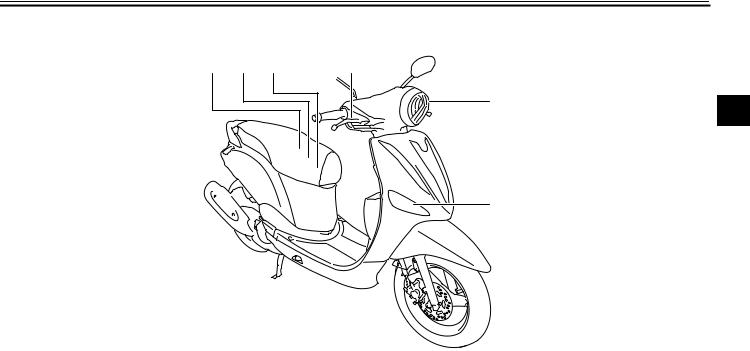
DESCRIPTION
EAU10420
Right view
1 2 3  4
4
5 |
2 |
|
6
1.Owner’s tool kit (page 6-2)
2.Battery (page 6-23)
3.Main fuse (page 6-25)
4.Front brake fluid reservoir (page 6-19)
5.Headlight (page 6-26)
6.Front turn signal light (page 6-28)
2-2
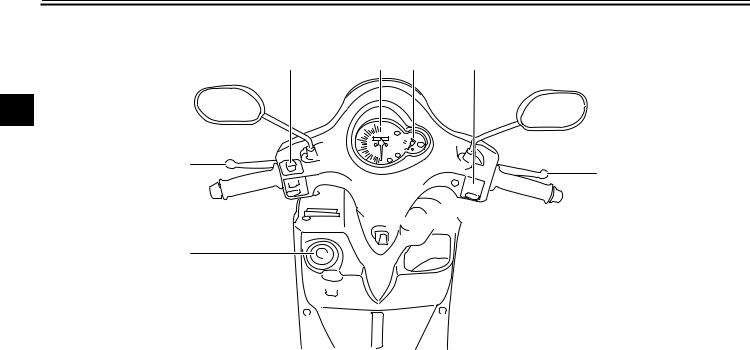
DESCRIPTION
EAU10430
Controls and instruments
2 |
4 |
5 |
7 |
2
3
6




 8
8
1
1.Fuel tank cap (page 3-5)
2.Left handlebar switches (page 3-3)
3.Rear brake lever (page 3-4)
4.Speedometer (page 3-3)
5.Fuel meter (page 3-3)
6.Front brake lever (page 3-4)
7.Right handlebar switch (page 3-3)
8.Main switch/steering lock (page 3-1)
2-3
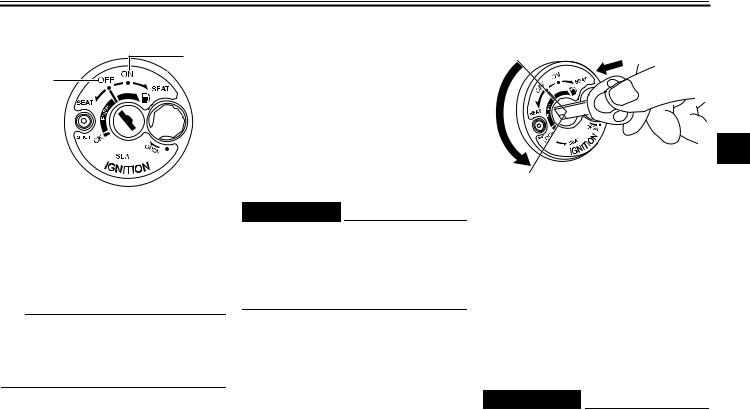
INSTRUMENT AND CONTROL FUNCTIONS
EAUU1030
Main switch/steering lock
ON
OFF
LOCK 


ZAUU0679
The main switch/steering lock controls the ignition and lighting systems, and is used to lock the steering, to open the seat, and to open the fuel tank cap. The various main switch positions are described below.
TIP
The main switch is equipped with a keyhole cover. (See page 3-2 for keyhole cover opening and closing procedures.)
EAU10650
ON
All electrical systems are supplied with power, the headlight, meter lighting, taillight and auxiliary light come on, and the engine can be started. The key cannot be removed.
EAU10661
OFF
All electrical systems are off. The key can be removed.
EWA10061
 WARNING
WARNING
Never turn the key to “OFF” or “LOCK” while the vehicle is moving. Otherwise the electrical systems will be switched off, which may result in loss of control or an accident.
EAUU1041
LOCK
The steering is locked, and all electrical systems are off. The key can be removed.
To lock the steering
1
2
3
1.Push.
2.Turn.
1.Turn the handlebars all the way to the left.
2.Push the key in from the “OFF” position, and then turn it to “LOCK” while still pushing it.
3.Remove the key.
To unlock the steering
Push the key in, and then turn it to “OFF” while still pushing it.
EWAU0041
 WARNING
WARNING
●Never turn the key to “OFF” or “LOCK” while the vehicle is moving; otherwise, the electri-
3-1
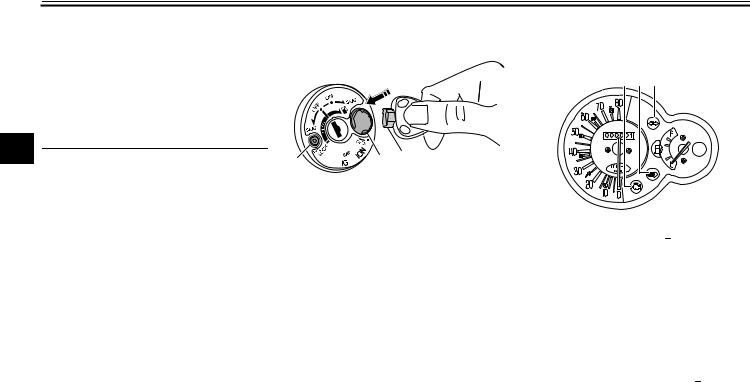
INSTRUMENT AND CONTROL FUNCTIONS
cal systems will be switched off, which may result in loss of control or an accident.
●If the vehicle turns over, and after placing it upright, ensure that there is no fuel leakage. If fuel is leaking, have a Yamaha dealer check the vehicle.
3
EAU55950 |
EAU11006 |
Keyhole cover |
Indicator lights and warning |
|
light |
|
1 2 3 |
2 
 1 3
1 3
1.Keyhole cover receptacle
2.“SHUT” button
3.Key bow
To open the keyhole cover
Insert the key bow into the keyhole cover receptacle as shown, and then turn the key to “OPEN” to open the cover.
To close the keyhole cover
Press the “SHUT” button to close the keyhole cover.
1.Engine trouble warning light “ 
 ”
”
2.High beam indicator light “  ”
”
3.Turn signal indicator light “ 
 ”
”
EAU11020
Turn signal indicator light “
 ”
”
This indicator light flashes when the turn signal switch is pushed to the left or right.
EAU11080
High beam indicator light “  ”
”
This indicator light comes on when the high beam of the headlight is switched on.
3-2
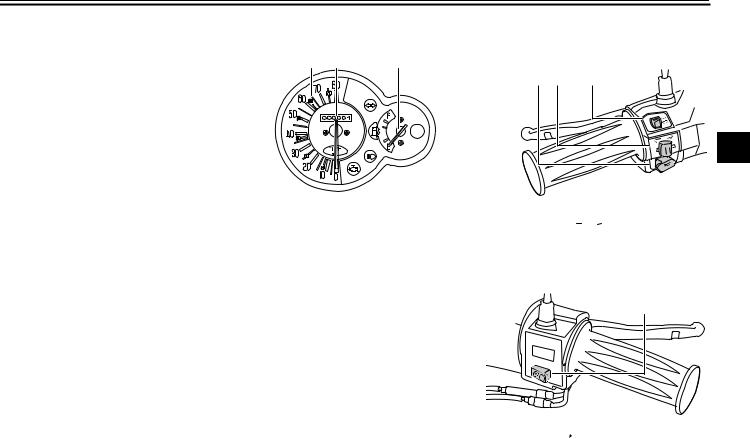
INSTRUMENT AND CONTROL FUNCTIONS
EAU11484
Engine trouble warning light “ 
 ”
”
This warning light comes on if a problem is detected in the electrical circuit monitoring the engine. If this occurs, have a Yamaha dealer check the selfdiagnosis system.
The electrical circuit of the warning light can be checked by turning the key to “ON”. The warning light should come on for a few seconds, and then go off.
If the warning light does not come on initially when the key is turned to “ON”, or if the warning light remains on, have a Yamaha dealer check the electrical circuit.
EAUU0080
Speedometer unit
1 |
2 |
3 |
1.Speedometer
2.Odometer
3.Fuel meter
The speedometer unit is equipped with a speedometer, an odometer and a fuel meter. The speedometer shows riding speed. The odometer shows the total distance traveled. The fuel meter indicates the amount of fuel in the fuel tank.
|
|
EAU1234C |
Handlebar switches |
||
Left |
|
|
3 |
2 |
1 |
|
|
3 |
ZAUU0684
1.Dimmer switch “  /
/  ”
”
2.Turn signal switch “ /
/ ”
”
3.Horn switch “  ”
”
Right
1
1. Start switch “ ”
”
3-3

INSTRUMENT AND CONTROL FUNCTIONS
EAU12400
Dimmer switch “  /
/  ”
”
Set this switch to “  ” for the high beam and to “
” for the high beam and to “  ” for the low beam.
” for the low beam.
EAU12460
Turn signal switch “ /
/ ”
”
To signal a right-hand turn, push this switch to “ ”. To signal a left-hand
3turn, push this switch to “ ”. When released, the switch returns to the center position. To cancel the turn signal lights, push the switch in after it has returned to the center position.
”. When released, the switch returns to the center position. To cancel the turn signal lights, push the switch in after it has returned to the center position.
EAU12500
Horn switch “  ”
”
Press this switch to sound the horn.
EAU12901
Front brake lever
1
1. Front brake lever
The front brake lever is located on the right side of the handlebar. To apply the front brake, pull this lever toward the throttle grip.
EAU12951
Rear brake lever
1
ZAUU0687
1. Rear brake lever
The rear brake lever is located on the left side of the handlebar. To apply the rear brake, pull this lever toward the handlebar grip.
EAUM1132
Start switch “ ”
”
Push this switch while applying the front or rear brake to crank the engine with the starter. See page 5-1 for starting instructions prior to starting the engine.
3-4
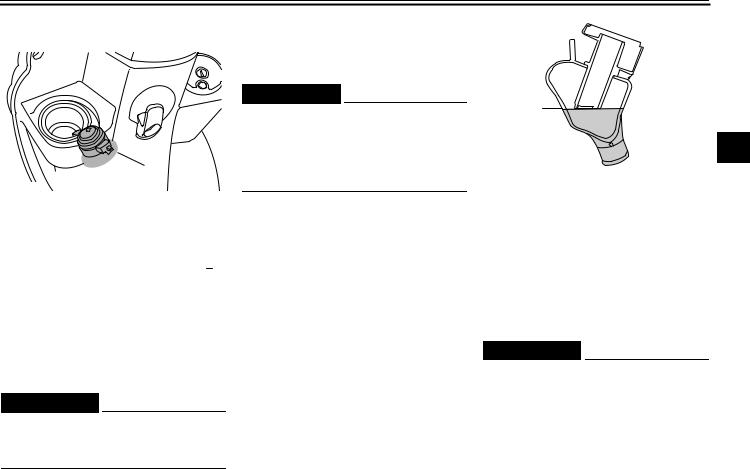
INSTRUMENT AND CONTROL FUNCTIONS
EAUU1161
Fuel tank cap
 1
1
ZAUU0688
1. Fuel tank cap
To open the fuel tank cap
Insert the key into the main switch and, while pushing the key in, turn it to “ ”. The lock will be released and the fuel tank cap can be removed.
”. The lock will be released and the fuel tank cap can be removed.
To install the fuel tank cap
Push the fuel tank cap down into its position. A clicking sound can be heard when the fuel tank cap is locked.
EWA10121
 WARNING
WARNING
Make sure that the fuel tank cap is properly closed and locked before riding. Leaking fuel is a fire hazard.
EAU13212
Fuel
Make sure there is sufficient gasoline in the tank.
EWA10881
 WARNING
WARNING
Gasoline and gasoline vapors are extremely flammable. To avoid fires and explosions and to reduce the risk of injury when refueling, follow these instructions.
1.Before refueling, turn off the engine and be sure that no one is sitting on the vehicle. Never refuel while smoking, or while in the vicinity of sparks, open flames, or other sources of ignition such as the pilot lights of water heaters and clothes dryers.
2.Do not overfill the fuel tank. Stop filling when the fuel reaches the bottom of the filler tube. Because fuel expands when it heats up, heat from the engine or the sun can cause fuel to spill out of the fuel tank.

 1
1
2
3
1.Fuel tank filler tube
2.Maximum fuel level
3.Wipe up any spilled fuel immediately. NOTICE: Immediately wipe off spilled fuel with a clean, dry, soft cloth, since fuel may deteriorate painted surfaces or plastic
parts. [ECA10071]
4.Be sure to securely close the fuel tank cap.
EWA15151
 WARNING
WARNING
Gasoline is poisonous and can cause injury or death. Handle gasoline with care. Never siphon gasoline by mouth. If you should swallow some gasoline or inhale a lot of gasoline vapor, or get some gasoline in your eyes, see your doctor immediately. If
3-5

INSTRUMENT AND CONTROL FUNCTIONS
|
|
gasoline spills on your skin, wash |
||
|
|
with soap and water. If gasoline |
||
|
|
spills on your clothing, change your |
||
|
|
clothes. |
||
|
|
|
|
|
|
|
|
|
EAU53011 |
|
|
|
|
|
3 |
|
Recommended fuel: |
||
|
|
Regular unleaded gasoline (Gaso- |
||
|
|
hol (E10) acceptable) |
||
|
|
Fuel tank capacity: |
||
|
|
4.4 L (1.16 US gal, 0.97 Imp.gal) |
||
|
|
|
|
|
|
|
|
|
ECA11400 |
|
|
NOTICE |
|
|
|
|
Use only unleaded gasoline. The use |
||
|
|
of leaded gasoline will cause severe |
||
|
|
damage to internal engine parts, |
||
|
|
such as the valves and piston rings, |
||
|
|
as well as to the exhaust system. |
||
|
|
|
||
|
|
Your Yamaha engine has been de- |
||
|
|
signed to use regular unleaded gaso- |
||
|
|
line with a research octane number of |
||
|
|
95 or higher. If knocking (or pinging) oc- |
||
|
|
curs, use a gasoline of a different brand |
||
|
|
or premium unleaded fuel. Use of un- |
||
|
|
leaded fuel will extend spark plug life |
||
|
|
and reduce maintenance costs. |
||
Gasohol
There are two types of gasohol: gasohol containing ethanol and that containing methanol. Gasohol containing ethanol can be used if the ethanol content does not exceed 10% (E10). Gasohol containing methanol is not recommended by Yamaha because it can cause damage to the fuel system or vehicle performance problems.
EAU13433
Catalytic converter
This model is equipped with a catalytic converter in the exhaust system.
EWA10862
 WARNING
WARNING
The exhaust system is hot after operation. To prevent a fire hazard or burns:
●Do not park the vehicle near possible fire hazards such as grass or other materials that easily burn.
●Park the vehicle in a place where pedestrians or children are not likely to touch the hot exhaust system.
●Make sure that the exhaust system has cooled down before doing any maintenance work.
●Do not allow the engine to idle more than a few minutes. Long idling can cause a build-up of heat.
3-6
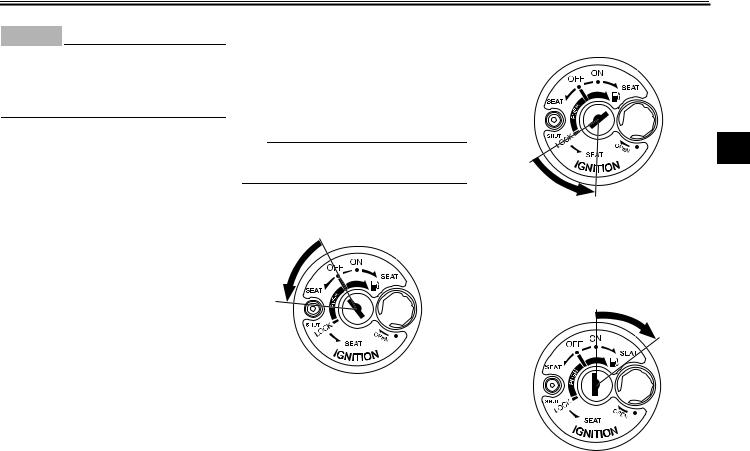
INSTRUMENT AND CONTROL FUNCTIONS
ECA10701
NOTICE
Use only unleaded gasoline. The use of leaded gasoline will cause unrepairable damage to the catalytic converter.
EAUU1173
Seat
To open the seat
1.Place the motorcycle on the centerstand.
2.Turn the key to “SEAT”.
TIP
Do not push inward when turning the key.
To open the seat from the “LOCK” position
3
To open the seat from the “OFF” position
1
ZAUU0690
1. Seat open (in “OFF” position)
From the “OFF” position, turn the key counterclockwise to “SEAT”.
ZAUU0691 1
1. Seat open (in “LOCK” position)
From the “LOCK” position, turn the key counterclockwise to “SEAT”.
To open the seat from the “ON” position
1
ZAUU0692
1. Seat open (in “ON” position)
3-7
